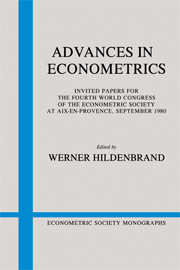Book contents
- Frontmatter
- 1 Qualitative response models
- 2 The identification problem in econometric models for duration data
- 3 The effects of time in economic experiments
- 4 Some recent developments on the distributions of single-equation estimators
- 5 Best uniform and modified Padé approximants to probability densities in econometrics
- 6 Identifiability and problems of model selection in econometrics
- 7 Causality, exogeneity, and inference
- 8 Generating mechanisms, models, and causality
- 9 Comparing alternative asymptotically equivalent tests
- 10 Conflict among testing procedures in a linear regression model with lagged dependent variables
- 11 Macroeconomic modeling based on econometric and simulation models for the Polish economy
9 - Comparing alternative asymptotically equivalent tests
Published online by Cambridge University Press: 05 January 2013
- Frontmatter
- 1 Qualitative response models
- 2 The identification problem in econometric models for duration data
- 3 The effects of time in economic experiments
- 4 Some recent developments on the distributions of single-equation estimators
- 5 Best uniform and modified Padé approximants to probability densities in econometrics
- 6 Identifiability and problems of model selection in econometrics
- 7 Causality, exogeneity, and inference
- 8 Generating mechanisms, models, and causality
- 9 Comparing alternative asymptotically equivalent tests
- 10 Conflict among testing procedures in a linear regression model with lagged dependent variables
- 11 Macroeconomic modeling based on econometric and simulation models for the Polish economy
Summary
In many econometric inference problems there are a number of alternative statistical procedures available, all having the same asymptotic properties. Because the exact distributions are unknown, choice among the alternatives often is made on the basis of computational convenience. Recent work in theoretical statistics has suggested that second-order asymptotic approximations can lead to a more satisfactory basis for choice.
In this chapter I shall discuss some implications of this statistical theory for hypothesis testing in econometric models. My comments are based on current research in progress with my co-workers Chris Cavanagh, Larry Jones, Dennis Sheehan, and Darrell Turkington. This work, in turn, borrows much from earlier studies by the statisticians Chibisov, Efron, and Pfanzagl and the econometricians Durbin, Phillips, and Sargan. Although my comments will concentrate on the problem of hypothesis testing, there are, of course, parallel theories for point and interval estimation.
The basic idea underlying second-order asymptotic comparisons of tests is simple. Tests that are asymptotically equivalent often differ in finite samples. Although the exact sampling distributions may be difficult to derive, the first few terms of an Edgeworth-type series expansion for the distribution functions usually are available. The tests can then be compared using the Edgeworth approximations. Of course, it is not very interesting to compare tests unless they have the same significance level. Therefore, we first approximate the distributions of the test statistics under the null hypothesis and, based on that approximation, modify the tests so that they have the same probability of a type I error. Then we use another Edgeworth series, derived under the alternative hypothesis, to approximate the power functions of the modified tests.
- Type
- Chapter
- Information
- Advances in Econometrics , pp. 255 - 262Publisher: Cambridge University PressPrint publication year: 1983



